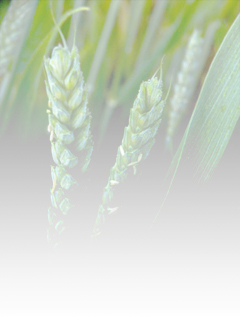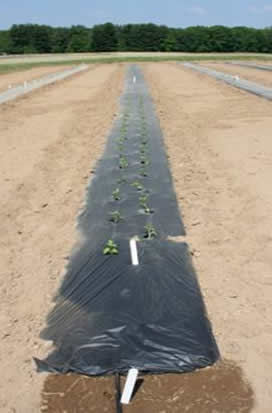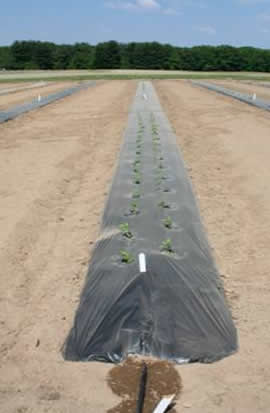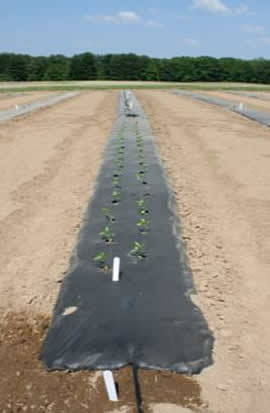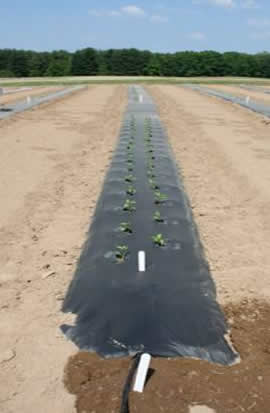Evaluation of Biodegradable Mulch Films (PREC)
(Smith, Sams and Deyton) |
||||||||||||||||||||
|
The purpose of this study was to determine the durability and affordability of biodegradable films as an alternative to traditional polyethylene plastic mulches in strawberry production. Four different biodegradable mulches were tested against a 1.25 mil black polyethylene control in a randomized complete block design (4 reps/teatment). The biodegradable mulches included:
Mulch materials (4-feet wide) were applied to the soil at the Plateau Research and Education Center in Crossville, TN on September 10, 2007 using a 6-inch bed-forming mulch layer. The soil had a pH of 6.3 and was extremely dry. 'Sweet Charlie' strawberry plugs were transplanted on September 25, 2007. Plants were spaced 12 inches apart in-row on double rows spaced 16 inches apart in 25-foot plots. Fertility was managed by fertigation throught he drip tape. Annual ryegrass was sown in the aisles, and electric fencing was set up around the perimeter of the plot. Application of mulch materials All biodegradable films laid as well as the polyethylene mulch, with the exception of the BioBag material. Four problems were encountered with the BioBag mulch: 1) it was damaged during shipping, so a portion of the roll needed to be removed before laying; 2) the interior cardboard cylinder was too wide for the mulch layer; 3) the mulch was weak and consistently broke from the roll while laying; and 4) the wheels on the mulch layer tended to damage the plastic on the bed shoulders. Longevity of mulch materials 15 days after application: At the time of tranpslanting (15 days after mulches were laid) all of the films except the BioBag material were intact and did not show signs of visible degradation. The BioBag mulch had begun to rip in a number of places and most replicates showed signs of degradation. 44 days after application: Some small holes appeared and a few weeeds began to emerge in all materials, including the polyethylene plastic mulch. With the esxception of the BioBag film, it did not appear as though the biodegradable mulches were beginning to degrade or lacking strength. The BioBag material was highly degraded in all replicates. 89 days after application: All mulches appeared to be in the same condition as they were 44 days after application. A number of ryegrass volunteers had emerged in all treatments, and cool season weeds were becoming a problem in the transplanting holes. Durability After 89 days, it appeared that the 0.6 mil BioTELO, 0.8 mil BioTELO, and 1.0 mil Ecofilm performed as well as the 1.25 mil polyethylen plastic. Affordability The biodegradable mulches are approximately 2-3 times more expensive than the polyethylen plastic. However, this is simply the cost to purchase the materials and does not take into account he removal and disposal expenses for the nondegrabele plastic mulches. Cost of mulch films:
$ Prices do not include shipping. Cost for hsipping 4 rolls of BioTELO was $258 and 1 roll of BioBag was $35. # Calculated using 6 feet between rows and 4-foot wide material. * This was a sample roll and is not yet commercially available. We are continuing to examine the use of biodegradable mulches in other crops and studying experimental fabrics that may be the next-generation of biodegrabale mulches.
|
|
||||||||||||||||||


